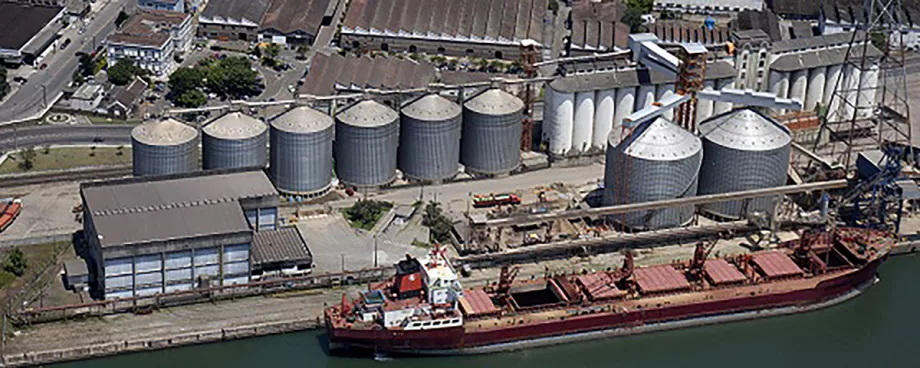“We have a complicated geographic position, because we are between a passenger terminal to the north and the Brazilian Navy to the south, and across the street from the port authority,” explained Vinicius Pina, Operations Director for T-Grão. “As our production has increased over the years, so have fugitive dust emissions, and we’ve worked closely with regulators and neighbors to address air quality issues.”
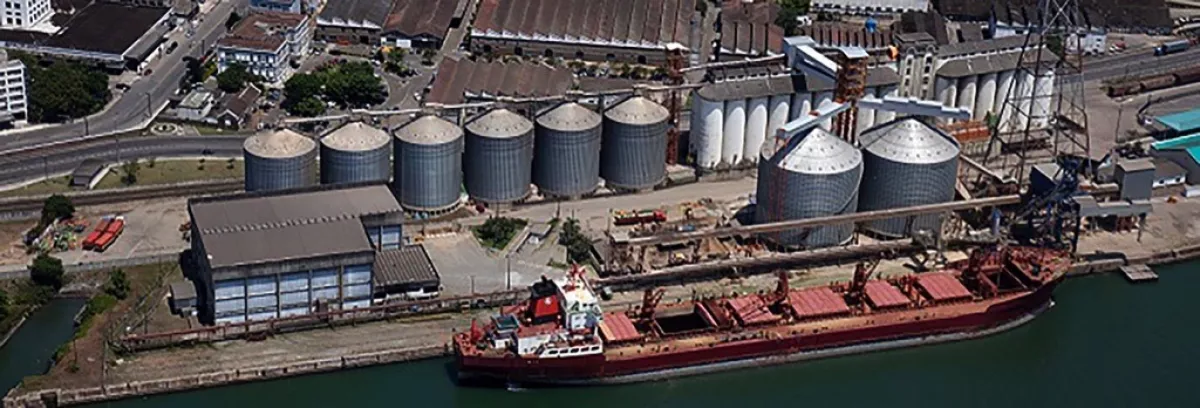
The Port of Santos in São Paulo is the busiest in Latin America, spanning approximately 8 square kilometers (3 square miles). Operating at Terminal 26, T-Grão manages the import and export of over 4 million st/y (3.6 million mt/y) of malt, wheat, soy and maize. Unloading vessels using two industrial vacuum units with an offloading capacity of 330 st/h (300 mt/h) each and a loading capacity of 1433 st/h (1,300 mt/h), the company manages 42 concrete silos and 8 massive metal silos, totaling 126,000 st (114,000 mt) of storage capacity.
Transfer points at T-Grão range between 32-50 feet (10-15 m) in height. The fugitive emissions affected air quality and visibility in the immediate work areas, forcing personnel to wear protective masks when working around any part of the conveyor system. The dust often traveled beyond the site line.
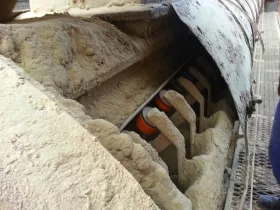
Before the chute upgrade, a cleaning crew of 45 workers spent ~24 hours per month on dust and spillage cleanup. However, according to managers, grain particulates must be cleaned and disposed of correctly, as even low levels of exposure can cause respiratory discomfort and sore throat, as well as nasal and eye irritation. “The investment for cleaning equipment was high,” Pina continued.
With complaints from neighbors and ongoing internal air quality issues, T-Grão turned to Martin Engineering Brazil for help developing a solution. Technicians discovered that, due to the height of the transfer chute, when cargo hit the belt, the pressure within the loading chute increased, pushing particulates at a high velocity out of any gap that was not sealed. Moreover, because of inadequate belt cleaning, carryback on the return run of the conveyor led to spillage and dust along the entire structure.
The result was large amounts of fugitive dust in the area, reducing air quality and visibility, settling on all surfaces and fouling rolling components. Seizing idlers contributed to belt mistracking and spillage, further increasing operating costs for cleaning, maintenance and downtime.
Transfer Point Design
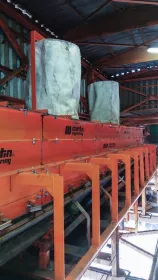
After constructing a longer sealed enclosure with the ability to control airflow and give dust extra space to settle, technicians added several other critical components. A heavy-duty impact cradle was installed to protect against impact and friction wear on the belt, which reduces maintenance and prolongs operational life. It features a top layer of slick UHMW polymer molded to a base of impact-absorbing SBR rubber, all reinforced with a steel support structure able to withstand as much as 17,000 pounds (53.4 to 75.6 kN) of force.
Extending from the impact cradle down the length of the settling zone are a series of slider cradles. Using a smooth UHMW polymer “box bar” engineered to prevent heat buildup, the design supports the edges of the belt to eliminate sag and prevent spillage, stabilizing the belt’s path and helping the skirting maintain a tight seal.
To offer further belt support, track-mounted idlers are placed in between the cradles to retain a straight belt profile, preventing “pinch points” that can damage the belt over time and sag points that allow spillage. Utilizing sliding frames on a stationary base, the rolling components are easily and safely installed and serviced.
After the belt leaves the settling zone, a belt tracker now minimizes belt wander that can be caused by uneven cargo loading. Using rotating troughed idlers connected to sensitive extension arms with rollers that ride both sides of the belt edge, the unit detects slight variations in the path and adjusts the idler before the belt drifts off its path.
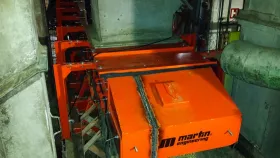
To complete the total system solution, Martin Engineering technicians installed a primary belt cleaning blade and spring tensioner system designed to remove carryback and keep a tight seal across the blade profile with minimal wear on the belt or splice. As a compliance measure, technicians also installed safety guards to prevent reach-in hazards. Sealed access hatches now allow safe observation and maintenance of components.
Results
When the conveyor was activated, operators immediately observed significant results. As material moved through the system, particulates remained within the enclosure and either collected in the dust bags or settled back into the cargo flow. With less carryback on the return side of the belt, dust was drastically reduced in the immediate area around the conveyor system at both the loading and discharge zones.
After a lengthy observation period, operators report that there has been less downtime for cleanup and maintenance, as well as improved workplace safety. In addition, managers have enjoyed a reduction in complaints from neighbors and less scrutiny from authorities inspecting the port for air quality.
“Our dust control efforts have set an example that is now being considered by terminals up and down the port,” Pina concluded. “Working with the Martin Engineering team has been an excellent experience, and we are now planning to install a similar design on several of our other transfer points.”
■



